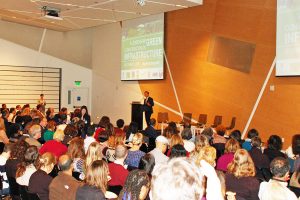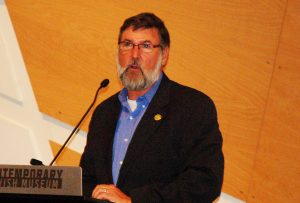
Assemblymember David Chiu welcomes attendees to the Green Infrastructure Leadership Conversation. Photo by Alec MacDonald.
“It’s not easy being green,” quipped Assemblymember David Chiu, borrowing Kermit the Frog’s tagline to encapsulate the challenge of confronting climate change. Addressing a capacity crowd at last Friday’s “Green Infrastructure Leadership Conversation” in San Francisco, the rest of the state legislator’s opening remarks took a more serious tone, in large part due to new political realities — which he alluded to by characterizing this past Election Day as “Armageddon for our environment.”
He declared that protecting the environment will necessitate unprecedented coordination between government, businesses, and nonprofits, a set of sectors solidly represented in his audience of more than 100 members. According to Chiu, this type of collaboration could produce more individual green infrastructure projects, while also serving broader civic needs related to jobs, housing, and transportation. And, the results would provide important models to replicate elsewhere.
“We all know that when the Bay Area leads, California follows,” he said, “and when California leads, the rest of the country and the world follows.”
Highlighting local examples already ripe for global emulation, Coastal Conservancy Executive Officer Sam Schuchat expanded on Chiu’s introduction by describing green infrastructure projects around the region. The list included rain gardens in Daly City, green roofs in San Jose, park amenities in San Francisco, flood protection along the Napa River, community gardens in San Rafael, and marsh restoration in Richmond. All this represents just an inkling of broader possibilities; as Schuchat noted, “There are a huge variety of opportunities to do this kind of work in the Bay Area.”
To help capitalize on those opportunities, he announced that the Coastal Conservancy will be offering a new round of Proposition 1 grants for “urban greening” projects in the nine-county region. As specified in the agency’s proposal solicitation, these projects must promise “at least two of the following benefits: increase groundwater recharge, enhance the natural flow of waterways, improve water quality, improve urban watershed health, create or enhance public green space, or expand urban forests.”
Schuchat said that four million dollars was on the table, although “we wish it could be more — we could easily spend ten times that amount.”
Subsequent speakers frequently returned to the issue of funding — usually with an air of pessimism. The San Francisco Estuary Partnership’s Josh Bradt cautioned that “federal dollars will be harder to come by” in the future, so Bay Area communities may need to consider taxing themselves in order to pay for green infrastructure. Assemblymembers Bob Wieckowski and Phil Ting raised concerns about the region’s prospects for receiving future cap-and-trade revenue; the District 10 legislator pointed out the program’s future was threatened by a lawsuit, while his District 19 colleague warned that forthcoming revisions to the program’s funding criteria will mean less money for the Bay Area. And East Bay Regional Park District General Manager Robert Doyle lamented that California has not approved a state parks bond for 14 years.
To end that dispiriting run, and to advance environmental causes overall, Doyle called for a proactive approach, advising, “Don’t sit down and complain about how bad things are — be the village that builds.”
Many other speakers evoked the village concept, emphasizing the importance of bringing together a broad array of community stakeholders for making projects happen. “You get more resources when you bring in a bigger coalition,” asserted UC Berkeley researcher Carol Zabin. As an example of this logic in practice, the labor expert cited Measure AA, the recently passed regional wetlands restoration parcel tax. Such unified efforts can yield plenty of smaller victories too, as Maya Rodgers testified about her own experience advocating for the renovation of Hilltop Park in her Bayview-Hunters Point neighborhood. As the Parks 94124 co-founder urged, “People have to talk, they have to collaborate.”
By the end of the Green Infrastructure Leadership Conversation, the “talk” portion of this directive had been amply accomplished. How the “collaborate” portion progresses is something that the Bay Area — and the rest of the world — will be waiting to see.
Thanks to San Mateo Countywide Water Pollution Prevention Program Manager Matt Fabry for providing the Monitor with his Green Infrastructure Leadership Conversation presentation slides, which he was unable to display during the “Greening, Housing, and Transportation” breakout discussion due to a problem with the facility’s projection system. Those slides, which include illustrated explanations of how green infrastructure can serve to better manage stormwater, may be downloaded by clicking here.
Read more about managing stormwater with green infrastructure and about recent developments in California’s cap-and-trade program in the December 2016/January 2017 edition of the Monitor.

